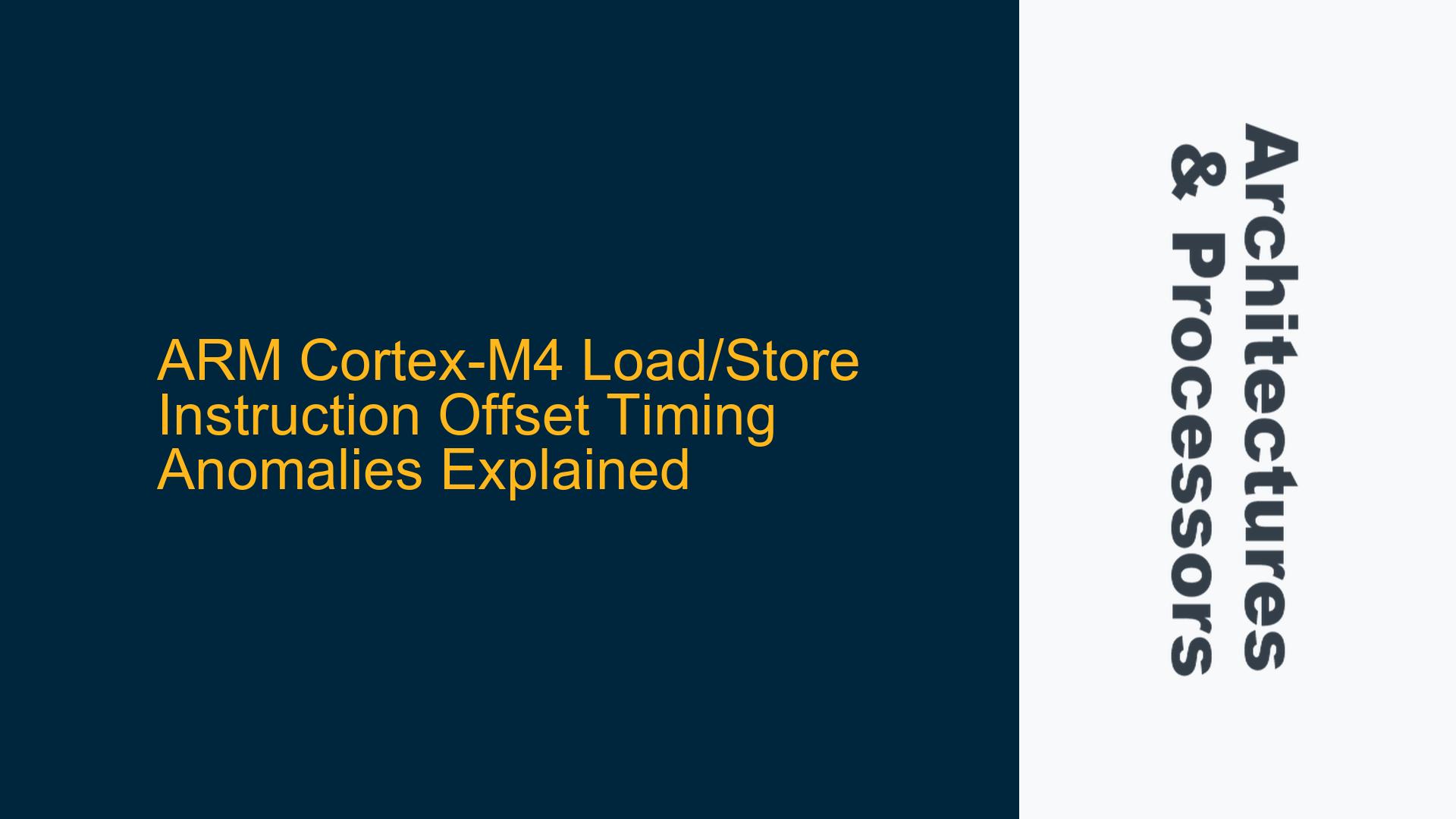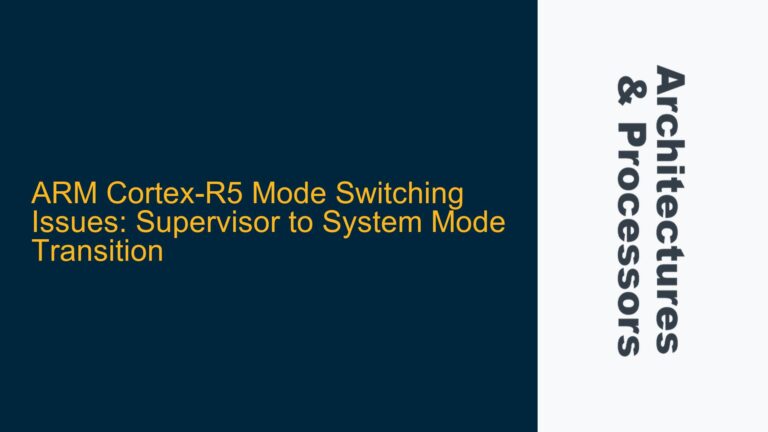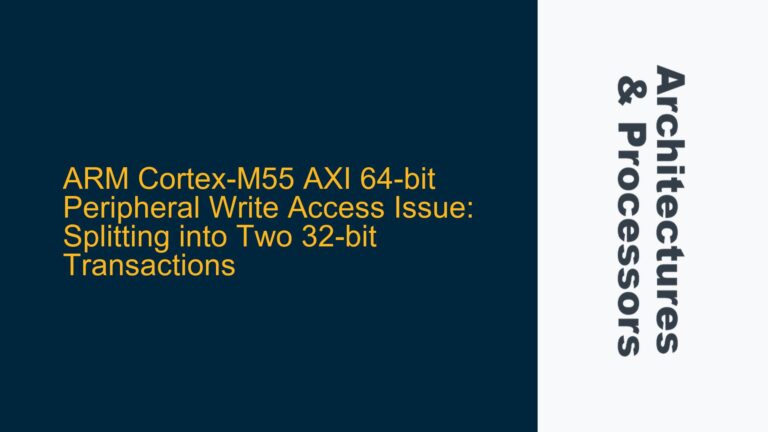ARM Cortex-M4 Load/Store Instruction Offset Timing Anomalies
The ARM Cortex-M4 processor, a widely used microcontroller core, exhibits a peculiar behavior when executing load and store instructions with specific offset values. This behavior manifests as unexpected variations in clock cycle consumption for offsets starting from 30 (decimal) and beyond. The anomaly is particularly noticeable when the offset is applied in the context of memory access instructions, such as LDR (Load Register) and STR (Store Register). The observed behavior deviates from the expected cycle counts as per the ARM Cortex-M4 technical reference manual, raising questions about the underlying causes and potential implications for firmware optimization and timing-critical applications.
The issue is characterized by the following observations:
- For an offset of 30 (decimal), the clock cycle consumption is 1, contrary to the expected 2 cycles.
- Subsequent offsets exhibit irregular cycle counts: 31 takes 3 cycles, 32 takes 2 cycles, 33 takes 3 cycles, and from 34 onwards, the cycle count resets to 1.
- This pattern repeats for higher offset values, suggesting a systemic issue rather than an isolated anomaly.
Understanding this behavior requires a deep dive into the ARM Cortex-M4 architecture, particularly its memory access mechanisms, pipeline structure, and the interaction between the processor core and the memory subsystem.
Memory Access Pipeline Stalls and Offset Alignment
The ARM Cortex-M4 employs a 3-stage pipeline (Fetch, Decode, Execute) and incorporates a Memory Protection Unit (MPU) and a Floating Point Unit (FPU) for enhanced performance. The memory access pipeline is designed to handle load and store operations efficiently, but certain conditions can lead to pipeline stalls, affecting the overall cycle count.
One of the primary factors influencing the cycle count is the alignment of the memory address being accessed. The ARM Cortex-M4 requires that memory accesses be aligned to the size of the data being transferred. For example, a 32-bit load or store operation must be aligned to a 4-byte boundary. Misaligned accesses can result in additional cycles due to the need for multiple memory transactions.
In the context of the observed anomaly, the offset value directly affects the alignment of the memory address. For instance, an offset of 30 (decimal) results in an address that is not aligned to a 4-byte boundary, potentially causing a pipeline stall. However, the Cortex-M4’s memory access logic is optimized to handle certain misaligned accesses efficiently, which might explain the reduced cycle count for an offset of 30.
Another factor to consider is the interaction between the processor’s pipeline and the memory subsystem. The Cortex-M4’s pipeline is designed to overlap memory access with other operations, but this overlap can be disrupted by certain memory access patterns. The irregular cycle counts observed for offsets beyond 30 suggest that the pipeline is encountering stalls or bubbles due to the specific alignment and access patterns induced by these offsets.
Implementing Address Alignment Checks and Pipeline Optimization Techniques
To address the timing anomalies observed with specific offset values in load and store instructions on the ARM Cortex-M4, several troubleshooting steps and optimization techniques can be employed. These steps aim to ensure consistent and predictable cycle counts, which are crucial for timing-critical applications.
Address Alignment Checks:
The first step in resolving the timing anomalies is to ensure that all memory accesses are properly aligned. This can be achieved by implementing address alignment checks in the firmware. For example, before executing a load or store instruction, the firmware can verify that the target address is aligned to the size of the data being transferred. If the address is misaligned, the firmware can adjust the address or use alternative instructions to ensure proper alignment.
Pipeline Optimization Techniques:
Optimizing the pipeline to minimize stalls and bubbles is another critical step. This can be achieved by reordering instructions to reduce dependencies and by using techniques such as loop unrolling and software pipelining. Additionally, the use of prefetching and caching mechanisms can help to mitigate the impact of memory access latency on the pipeline.
Cycle Count Verification:
To verify the effectiveness of the implemented optimizations, it is essential to measure the cycle counts for different offset values. This can be done using performance counters or by instrumenting the firmware with cycle-accurate timing measurements. By comparing the measured cycle counts with the expected values, any remaining anomalies can be identified and addressed.
Memory Access Pattern Analysis:
Analyzing the memory access patterns can provide insights into the root cause of the timing anomalies. This involves examining the sequence of load and store instructions and identifying any patterns that might lead to pipeline stalls or inefficient memory access. Tools such as simulators and profilers can be used to visualize and analyze the memory access patterns.
Firmware Adjustments:
Based on the findings from the address alignment checks, pipeline optimization, cycle count verification, and memory access pattern analysis, adjustments can be made to the firmware. These adjustments might include modifying the offset values, reordering instructions, or using alternative memory access instructions to achieve consistent and predictable cycle counts.
By following these troubleshooting steps and optimization techniques, the timing anomalies observed with specific offset values in load and store instructions on the ARM Cortex-M4 can be effectively addressed, ensuring reliable and efficient operation of the microcontroller in timing-critical applications.






